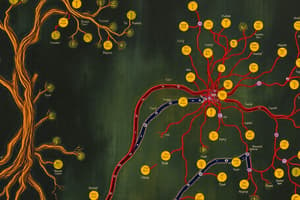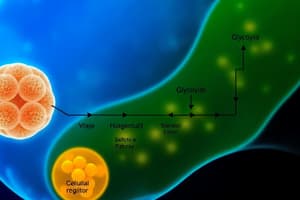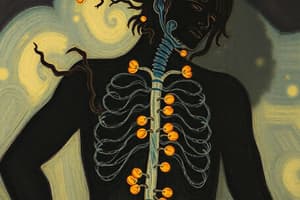Podcast
Questions and Answers
What is the primary function of glycolysis?
What is the primary function of glycolysis?
- To produce glucose from starch
- To transport glucose across the cell membrane
- To synthesize fatty acids from pyruvate
- To convert glucose to pyruvate and generate ATP (correct)
Where does glycolysis occur in eukaryotic cells?
Where does glycolysis occur in eukaryotic cells?
- Mitochondria
- Nucleus
- Cytosol (correct)
- Endoplasmic Reticulum
How many molecules of ATP are generated net from one molecule of glucose during glycolysis?
How many molecules of ATP are generated net from one molecule of glucose during glycolysis?
- 4 ATP
- 6 ATP
- 0 ATP
- 2 ATP (correct)
Which of the following is NOT a source of glucose for glycolysis?
Which of the following is NOT a source of glucose for glycolysis?
What is the chemical nature of glucose that gets converted during glycolysis?
What is the chemical nature of glucose that gets converted during glycolysis?
What is the primary function of hexokinase in glucose metabolism?
What is the primary function of hexokinase in glucose metabolism?
Which enzyme catalyzes the conversion of glucose-6-phosphate to fructose-6-phosphate?
Which enzyme catalyzes the conversion of glucose-6-phosphate to fructose-6-phosphate?
In which step of glycolysis is fructose-1,6-bisphosphate formed?
In which step of glycolysis is fructose-1,6-bisphosphate formed?
What type of reaction occurs when fructose-1,6-bisphosphate is cleaved by aldolase?
What type of reaction occurs when fructose-1,6-bisphosphate is cleaved by aldolase?
What is the role of glyceraldehyde-3-P dehydrogenase in glycolysis?
What is the role of glyceraldehyde-3-P dehydrogenase in glycolysis?
Flashcards
What is glycolysis?
What is glycolysis?
Glycolysis is the metabolic pathway that breaks down one glucose molecule into two pyruvate molecules, generating a net of two ATP molecules.
Describe the process of glycolysis.
Describe the process of glycolysis.
A series of chemical reactions that convert a 6-carbon glucose molecule into two 3-carbon pyruvate molecules.
What is the energy output of glycolysis?
What is the energy output of glycolysis?
Glycolysis generates a net gain of 2 ATP molecules per glucose molecule. This energy is essential for various cellular activities.
What are the other functions of glycolysis besides ATP production?
What are the other functions of glycolysis besides ATP production?
Signup and view all the flashcards
How does glucose enter the cell for glycolysis?
How does glucose enter the cell for glycolysis?
Signup and view all the flashcards
Phosphorylation of Glucose
Phosphorylation of Glucose
Signup and view all the flashcards
Isomerization of Glucose-6-phosphate
Isomerization of Glucose-6-phosphate
Signup and view all the flashcards
Phosphorylation of Fructose-6-phosphate
Phosphorylation of Fructose-6-phosphate
Signup and view all the flashcards
Cleavage of Fructose-1,6-bisphosphate
Cleavage of Fructose-1,6-bisphosphate
Signup and view all the flashcards
Conversion of Dihydroxyacetone Phosphate
Conversion of Dihydroxyacetone Phosphate
Signup and view all the flashcards
Study Notes
Glycolysis Overview
- Glycolysis is a fundamental metabolic pathway found in nearly all cells (prokaryotic and eukaryotic).
- It takes place in the cell's cytosol.
- The pathway converts one glucose molecule into two pyruvate molecules.
- Glycolysis serves two key functions: ATP generation and the production of intermediates for other biomolecules (e.g., amino acids, fatty acids).
- Glucose is the primary fuel for most organisms.
- Glycolysis produces a net gain of 2 ATP molecules per glucose molecule.
- Pyruvate can be further metabolized to produce more ATP.
Glucose Source
- Most dietary carbohydrates are in the form of starch (a polymer of glucose).
- Glucose is also obtained from lactose (milk sugar) and sucrose (table sugar).
- Maltose, a product of starch breakdown, is a rich source in certain foods undergoing fermentation.
- Glucose transport into the cell is facilitated by specific transporters.
Glycolysis Steps
-
Step 1: Phosphorylation of Glucose: Glucose is phosphorylated to glucose-6-phosphate. This step is irreversible and traps the glucose inside the cell. The enzyme responsible is hexokinase.
-
Step 2: Isomerization: Glucose-6-phosphate is converted to fructose-6-phosphate via isomerization. This step is reversible.
-
Step 3: Phosphorylation (second): Fructose-6-phosphate is phosphorylated to fructose-1,6-bisphosphate. This step is irreversible and is a key regulatory step in glycolysis. Catalyzed by phosphofructokinase.
-
Step 4: Cleavage: Fructose-1,6-bisphosphate is cleaved into two 3-carbon molecules: dihydroxyacetone phosphate and glyceraldehyde-3-phosphate. This is a reversible reaction that creates two 3-carbon molecules.
-
Step 5: Oxidation and Phosphorylation: Glyceraldehyde-3-phosphate is oxidized and phosphorylated, creating 1,3-bisphosphoglycerate. This reaction generates high-energy phosphate bonds. The enzyme is glyceraldehyde-3-P dehydrogenase.
-
Step 6: Phosphoryl Transfer: 1,3-bisphosphoglycerate transfers a phosphate group to ADP, forming ATP (substrate-level phosphorylation) and 3-phosphoglycerate. The enzyme is phosphoglycerate kinase.
-
Step 7: Isomerization: 3-phosphoglycerate is rearranged to 2-phosphoglycerate via the enzyme phosphoglycerate mutase.
-
Step 8: Dehydration: 2-phosphoglycerate loses a water molecule, forming phosphoenolpyruvate (PEP). Catalyzed by enolase.
-
Step 9: Phosphoryl Transfer (final): PEP donates its phosphate group to ADP, creating ATP (substrate-level phosphorylation) and pyruvate. The enzyme is pyruvate kinase.
Important Notes
- Kinases are enzymes that transfer phosphate groups.
- Isomerases rearrange atoms within a molecule, without changing its overall composition.
Net Reaction
-
Glucose + 2 ADP + 2 NAD+ → 2 Pyruvate + 2 ATP + 2 NADH + 2 H+ + 2 H2O
-
Glycolysis operates without oxygen requirement, making it anaerobic.
-
Further energy production is possible with oxygen present.
Studying That Suits You
Use AI to generate personalized quizzes and flashcards to suit your learning preferences.




